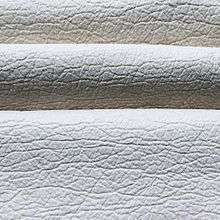Piñatex
Piñatex is a natural leather alternative made from cellulose fibres extracted from pineapple leaves, PLA (polylactic acid), and petroleum-based resin.[1] Piñatex was developed by Dr Carmen Hijosa and first presented at the PhD graduate exhibition at the Royal College of Art, London. Piñatex is manufactured and distributed by Dr Hijosa's company Ananas Anam Ltd.[2]
 Piñatex fabric in white | |
| Type | artificial leather |
|---|---|
| Inventor | Dr Carmen Hijosa |
| Manufacturer | Ananas Anam |
| Website | www.ananas-anam.com |
Development
Piñatex's development began when Dr Hijosa was working as consultant in the leather goods industry in the Philippines in the 1990s. She observed the leather produced there by was poor quality, environmentally unsustainable and bad for the people involved in the industry.[3] Dr Hijosa was inspired by the barong tagalog, a traditional Philippine garment worn untucked over an undershirt and made of pineapple fibers. She then spent seven years developing the product through a PhD at the Royal College of Art in London, and joint collaborations with Bangor University in Wales, Northampton Leather Technology Center, Leitat Technological Centre in Spain, alongside NonWoven Philippines Inc. in Manila, and Bonditex S.A., a textile finishing company in Spain.[3][4][5]
Production
Piñatex is created by felting the long fibres from pineapple leaves together to create a non-woven substrate.[2][6] The pineapple industry globally produces 40,000 tonnes of waste pineapple leaves each year, which are usually left to rot or are burned.[2] Approximately 480 leaves (the waste from 16 pineapple plants) are needed to create 1 square metre of material. The material uses the long leaf fibres which are separated by the pineapple farmers for additional income, the leftover biomass from the process can be used as a fertiliser.[6][5][6][2]
Piñatex is produced partially from a waste product that requires no additional land, water, pesticides or fertilizers. It also avoids the use of toxic chemicals and heavy metals used in animal leather production and has none of the wastage of leather caused by the shape of the animal's skin.[2][3]
 Making Piñatex, decorticating pineapple leaves
Making Piñatex, decorticating pineapple leaves After the fibre from the pineapple leaves is decorticated and washed the farmers hang it up to dry
After the fibre from the pineapple leaves is decorticated and washed the farmers hang it up to dry
Properties
Piñatex is produced in a range of colours and finishes, including a textured surface and a metallic finish. It has been described as having a softer, more pliable, "leather-like" texture than other synthetic leathers.[7] It can also be cut, stitched, embossed and embroidered for different design uses.[5] Piñatex is not biodegradable.[1] Like all natural materials, it will wear and age dependent on use and care.[8]
Sustainability
Piñatex is currently not biodegradable.[1] It is composed of a mixture of pineapple leaves, PLA (Polylactic acid), and petroleum-based resins.[1] PLA, also known as bio-plastic, is sourced from renewable resources and is commonly labeled 'biodegradable'. However, the United Nations Environmental Programme issued a report in 2015 concluding, "The adoption of plastic products labelled as 'biodegradable' will not bring about a significant decrease either in the quantity of plastic entering the ocean or the risk of physical and chemical impacts on the marine environment, on the balance of current scientific evidence."[9] Petroleum and its byproducts, such as the one used in Piñatex, have raised environmental concerns (see Intergovernmental Panel of Climate Change).[10]
In manufactured goods
Piñatex is breathable and flexible. It has been used in the manufacture of such products as bags, shoes, wallets, watch bands, and seat covers. The textile is being further developed for use in clothing.[6] Products have been produced by designer Ally Capellino, LIAN & LIV, Time IV Change, ROMBAUT, and Nae; prototypes have been created by Puma and Camper.[3][5] Bourgeois Boheme, a vegan footwear label, uses Piñatex in their sandals.[7]
Recognition
In 2016 Piñatex won the Arts Foundation UK award for Material Innovation and in 2015 Dr Hijosa was finalists of the Cartier Women's Initiative Awards.[11][2] Piñatex is a PETA certified vegan fashion label.[12]
Pineapple leather was highlighted on the first page of, and throughout, L.J.M. Owen's book, Egyptian Enigma. It was the featured fabric on a journal gifted to the main character, Dr. Elizabeth Pimms, by her sister Sam Pimms, an ardent vegetarian.
External links
References
- "FAQs". Piñatex. Retrieved 21 March 2019.
- "Leather alternative Piñatex is made from pineapple leaves". Dezeen. 9 June 2016. Retrieved 16 September 2016.
- "This Gorgeous, Sustainable "Leather" Is Made From Pineapple Waste". 25 April 2016. Retrieved 17 September 2016.
- "Vegan Leather Made From Pineapples is Cruelty-Free and Biodegradable". Retrieved 16 September 2016.
- Hickey, Shane (21 December 2014). "Wearable pineapple fibres could prove sustainable alternative to leather". The Guardian. ISSN 0261-3077. Retrieved 17 September 2016.
- "Leather alternative replaces animal hide with pineapple leaves | Science! | Geek.com". @geekdotcom. Retrieved 16 September 2016.
- Klein, Alice (16 June 2018). "Insight Vegan Clothes: What not to wear". New Scientist. 238 (3182): 22–23. doi:10.1016/S0262-4079(18)31060-1.
- "Pinatex. Luxury items from pineapple waste". Goodsmiths. 31 January 2019. Retrieved 9 April 2019.
- Kershaw, Peter John (2015). Biodegradable Plastics & Marine Litter (PDF). United Nations Environment Programme. ISBN 978-92-807-3494-2.
- "The truth about big oil and climate change". The Economist. 9 February 2019. ISSN 0013-0613. Retrieved 21 March 2019.
- "Carmen Hijosa | Award Editions". award-editions.cartierwomensinitiative.com. Retrieved 17 September 2016.
- "Our Company – ananas anam". Retrieved 16 September 2016.